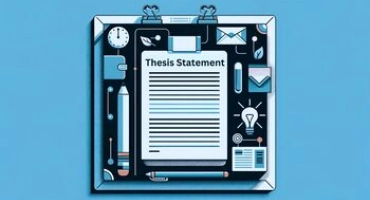How to Write a Good Argumentative Essay
Table of contents
- 1 Key Takeaways
- 2 What Is an Argumentative Essay?
- 3 Rhetorical Devices in Argumentative Writing
- 4 Basic Argumentative Essay Structure
- 5 Types of Arguments in Argumentative Writing
- 6 How to Write a Good Thesis
- 7 How to Write an Argumentative Essay?
- 8 Tips for Argumentative Writing
- 9 25 Argumentative Essay Topic Ideas
- 10 Final Tips
Argumentative essays help students develop a clear and reasoned position while engaging in an intellectually balanced exchange of ideas. This type of writing trains the ability to analyze evidence, evaluate differing viewpoints, and present logical, well-structured arguments.
When approached methodically, an argumentative essay becomes not only a tool of persuasion but also a disciplined exercise in critical thinking.
Key Takeaways
- Understand the purpose and core components of an argumentative essay before beginning the writing process.
- Develop a clear, debatable thesis that guides the structure of your argument.
- Support each claim with credible, well-researched evidence to strengthen your position.
- Use appropriate argumentative structures (Classical, Toulmin, Rogerian) to organize your reasoning effectively.
- Incorporate counterarguments to demonstrate awareness of alternative viewpoints and reinforce your credibility.
- Apply a systematic approach to outlining, drafting, and revising to ensure clarity and coherence.
If you need additional support or expert guidance, professional essay writers can help you refine your argument and ensure that your essay meets academic standards.
What Is an Argumentative Essay?
When it comes to argumentative academic essays, understanding where you stand is a good starting point. There’s no way to sugarcoat it: argumentative essays are about sharing your opinion on a contentious issue and trying to win people over to your way of thinking.
But the real key is this: to get your point across, you need to prove that what you’re saying is the truth – and that others should take note of it.
Argumentative essays often centre around literary works, so it’s worth remembering that you’re looking to dig up solid facts, put together a strong case, and then back it all up with top-notch evidence. And let’s be real – anyone can write an argumentative essay. But a good one is something entirely different: a real standout that gets people talking.
A well-crafted argumentative essay will typically have these hallmarks:
- Clear thesis statement;
- Controversial topic;
- Arguments based on evidence;
- Research-oriented;
- Counterargument consideration;
- Organization and structure;
- Persuasive language and rhetoric;
- Clarity and coherence;
- Critical thinking and deep analysis;
- Audience awareness.

Rhetorical Devices in Argumentative Writing
A strategy for persuading the reader is the rhetorical technique. This technique helps you appeal to your audience’s emotions and convince your opponent to think your way and even see your perspectives.
The great thing about using rhetorical devices in your argumentative paper is that they work for written academic essays and your speaking.
Aristotle states three basic types of rhetorical devices: logos, ethos, and pathos:
- Logos relies on logical reasoning, factual evidence, and coherent explanations.
- Ethos establishes the author’s credibility and stature, increasing the likelihood that your audience will take your statements seriously.
- Pathos appeals to the reader’s emotions, helping to highlight the human relevance of the issue without replacing logic or evidence.
By remembering these strategies and mastering their application, you can ensure that your arguments are as persuasive as possible and that no counterarguments are raised. This is the main point of any argumentative article.
Basic Argumentative Essay Structure
An argumentative essay’s framework deviates slightly from other types of essay writing. The essay can be broken down into three sections: the introduction, the body, and the conclusion. However, the specifics of what goes into each section will vary substantially from one job to the next.
The introduction is the opening section of an expository essay. The purpose of the introduction paragraph is to familiarize the reader with the work’s subject matter and provide background information. This section of the text is also meant to hook the reader’s interest and encourage them to continue exploring the piece.
Next second, third, and fourth paragraphs are body. This paragraph presents the essential concepts and elaborates on them in an argumentative piece of academic work. This is the evidence section, where you can lay it all out for your opponent and try to win them over.
Create a new paragraph for each central point you want to make.
Now for the conclusion and structure of argumentative essays. Here, you’ll need to detail the findings and opposing points you made during your research. The final results should always align with the expectations outlined in the initial sections.
Types of Arguments in Argumentative Writing
We aim to break down these persuasive strategies so you can use them in your workflow process with complete assurance. As you write argumentative essays, you can implement these ideas for expository essays as well.
Aristotelian (Classic)
Aristotle used reduction to the point of folly as one of his tricks. With this method, you have to start from the opposite side. You say that your chosen theory is wrong, and then you build on it to the point where it makes no sense.
The reader will then realize that such a statement is ridiculous and be convinced by your original point. Aristotle explained his method by saying that an idea can’t simultaneously be true and false.
Toulmin
According to Stephen Toulmin, effective argumentation relies on demonstrating the logical connection between a claim and the evidence supporting it. His model consists of six components:
the claim → grounds → warrant →backing → qualifier → rebuttal
CLAIM. Hypothesis to evaluate DATA:
- Datum #1
- Datum #2
- Datum #3
GROUNDS. Factual support that demonstrates why the claim is reasonable:
- Empirical research data
- Expert testimony
- Verified statistics
- Case studies or documented observations
WARRANTS. General principles or logical bridges that connect the grounds to the claim:
- Warrant #1
- Warrant #2
BACKING. Additional justification that supports the warrants and demonstrates why they are valid. Backing typically includes:
- Scientific studies
- Methodological explanations
- Historical or theoretical context
QUALIFIER. A statement that indicates the strength or scope of the claim:
- “Most likely,”
- “In most cases,”
- “Generally,”
- “Under these conditions,”
- “It is reasonable to conclude that…”
REBUTTAL. Acknowledgment and critical examination of opposing viewpoints:
- Identification of an existing counterargument
- Explanation of its limitations or weaknesses
- Presentation of evidence that refutes or qualifies the opposing view
Rogerian
The Rogerian model also has four steps for creating a concise thesis statement. Again, you can say these repeatedly as many times as you want. The Rogerian argument is based on the idea that both sides should be as tolerant and respectful as possible.
Here are the steps that will help you write an argument essay well and back up your point of view:
- Talk about the opposing points of view and what’s good about them.
- Find flaws in those points of view.
- Share your point of view.
- Try to find a way to solve the problem.
How to Write a Good Thesis
Beginning an argumentative essay with a well-developed thesis is a great way to grab the reader’s interest. It’s one sentence that can serve as a roadmap for the rest of the text and simplify things.
Naturally, at this point, you need to know what you are making, and your defined thesis statement needs some fine-tuning. There are three key points to take away from this, all of which can be used in argumentative essay format.
| Step | Description | Example |
| Start with a query | Your instructor may give you a question to answer. If you can’t find a suitable alternative or sufficient opposing point, you must create one yourself. | What impact has the internet had on the tech industry? |
| You should respond to that query right away | Applying the same reasoning as before, we find | In the technological sector, for instance, the internet has spurred exponential growth and opened up countless new avenues for exploration. |
| Make sure your thesis statement is spot-on. | Simply put, you need to modify it to fit in with the rest of your essay. We’ll give you the one that follows the same pattern as the one up top. | Internet-enabled devices that are both practical and beneficial to users have become a primary priority for the world’s largest technology companies. |
How to Write an Argumentative Essay?
The outline is an integral component that should be present in argumentative essay work, regardless of the specific topic or subject. In the process, you will also need a strong thesis statement to set the direction and focus of your writer’s position.
Also, don’t forget that the main argument must be present in the plan, and you must start with a strong opening statement. This is important for all papers, but even more so for argumentative essays since they are based on arguments and academic writing that will vividly support your opinion.
To make your argument even more compelling, using powerful argument transition words will help guide your reader through your points smoothly and logically.
The key components of an argumentative essay outline template include:
Intro:
- Hook: Start with a thought-provoking statement or statistic.
- Background information: Provide brief and necessary context on the issue.
- Thesis statement: Clearly state your stance on the topic and preview different types of arguments.
Body Paragraphs:
- Topic sentence: Introduce the first argument that supports your thesis.
- Explanation: Provide argument details, including reasoning examples.
- Rebuttal: Address and refute a potential counterargument with strong reasoning and evidence.
- Concluding sentence: Summarize the main points of your own argument and transition to the next paragraph.
- Restate the thesis: Emphasize the importance of your grounds.
- Summarize the main aspects.
- Concluding thoughts: Close with compelling statements.
Tips for Argumentative Writing
Learning how to write an argumentative essay, you can use these helpful tips in the writing process:
Choose the Topic or Define your Prompt
Selecting a compelling topic is crucial. Your choice will influence the evidence you can gather and the direction of your argument. Aim for topics that are debatable and allow for multiple perspectives.
Examples of topics:
- Two-sided: Is using technology in the classroom beneficial or harmful to students’ learning outcomes?
- One-sided (without counterarguments): Should cell phones be allowed in schools?
- One-sided (without counterarguments): Is homeschooling a better alternative to traditional schooling?
Make Up Your Mind on Different Perspectives
It’s essential to choose a side that is backed by sufficient evidence. Always engage with multiple viewpoints, but make your stance clear. Research both for and against the argument to make your case more persuasive.
Consider your Target Audience
Tailor your argument to your target audience. For instance, a paper for college students will use different reasoning and language compared to a paper aimed at business professionals or seniors. Ensure you do adequate research and adjust your writing style to your readers’ values and interests.
Find Accurate Facts
All the information you need to support your argument must be accurate and not slanted. You’ll need to use numbers, stories, studies, surveys, and more here. Don’t use ”lost” information that is useless. If you do that, a writer competing with you can make your writing look less accurate and essential.
Write a Draft
Don’t expect perfection in your first attempt. Write your first draft with all the essential facts and structure. It’s important to get your ideas down first and refine them in later revisions.
Edit and Proofread your Paper
The last tip, which is also the last step, is to proofread your paper, look for problems, and fix them. The goal is to make your work look good enough for a professor or teacher to read. For this step to be done right, you should always use all the ways you can. You can get help online and do a lot more.
25 Argumentative Essay Topic Ideas
Let’s showcase the top concepts that might serve as springboards for further thought, writing, and other creative endeavors. We’ve compiled 25 argumentative essay topics that we think you’ll find helpful:
- Is animal testing fair?
- Are teen beauty pageants justified?
- Is the ban on smoking in public places undemocratic?
- Should social media platforms be banned from collecting their users’ data?
- Should companies have to hire human workers overusing autonomous machines?
- Should phones be banned from vehicles?
- Has the internet made society better?
- Should parents limit screen time for kids?
- Is the use of nuclear energy a viable solution to address climate change?
- Should school uniforms be mandatory in public schools?
- Is it justifiable to use military force to intervene in foreign conflicts?
- Is online learning as effective as traditional classroom education?
- Should marijuana be legalized for recreational use?
- Should parents have the right to homeschool their children?
- Is social media contributing to increased loneliness and isolation?
- Should college athletes be paid for their participation?
- Is the use of animals for scientific research justified?
- Should the voting age be lowered to 16?
- Is censorship necessary in the digital age?
- Should the government provide universal basic income?
- Is using animals for entertainment, such as in circuses or zoos, ethical?
- Should the use of plastic bags be banned to protect the environment?
- Should genetically modified organisms (GMOs) be labeled on food products?
- Is it fair to implement affirmative action in college admissions?
- Should euthanasia be legalized?
Final Tips
To write a compelling argumentative essay, remember to start with a clear, debatable thesis and support it with credible evidence.
Consider counterarguments to strengthen your position and maintain a formal, academic tone throughout. A well-structured essay, supported by reliable sources, is key to persuading your readers.
If you need extra help, a custom essay writing company can assist you in refining your argument and ensuring that your essay is both logical and convincing.








